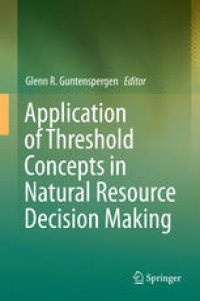
Ebook: Application of Threshold Concepts in Natural Resource Decision Making
Author: Glenn R. Guntenspergen (eds.)
- Tags: Environmental Management, Applied Ecology, Environmental Monitoring/Analysis
- Year: 2014
- Publisher: Springer-Verlag New York
- Edition: 1
- Language: English
- pdf
Natural resource managers face a complex decision-making environment characterized by the potential occurrence of rapid and abrupt ecological change. These abrupt changes are poorly accommodated by traditional natural resource planning and decision-making processes. As recognition of threshold processes has increased, contemporary models of ecological systems have been modified to better represent a broader range of ecological system dynamics. Key conceptual advances associated with the ideas of non-linear responses, the existence of multiple ecological stable states and critical thresholds are more likely the rule than the exception in ecological systems. Once an ecological threshold is crossed, the ecosystem in question is not likely to return to its previous state. There are many examples and a general consensus that climatic disruptions will drive now stable systems across ecological thresholds.
This book provides professional resource managers with a broad general decision framework that illustrates the utility of including ecological threshold concepts in natural resource management. It gives an entry into the literature in this rapidly evolving concept, with descriptions and discussion of the promising statistical approaches for threshold detection and demonstrations of the utility of the threshold framework via a series of case studies.
Scientists and managers have largely abandoned classic models that assume natural systems are in equilibrium and recognize the importance of understanding interactions between, and among, biotic and abiotic factors in ecosystems, and how these interactions lead to complexities that should be factored into natural resource management decisions. Even though the existence of ecological thresholds is becoming increasingly apparent, this has not been followed by its widespread adoption and incorporation into management decisions and goals. The ability to move from theory to application and make threshold concepts a problem solving tool for natural resource management remains a daunting challenge. This book addresses this challenge and shows how threshold concepts can be integrated into conservation and land management decision making.